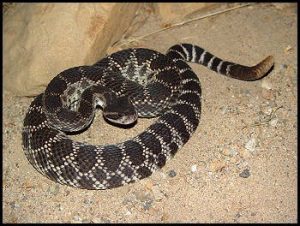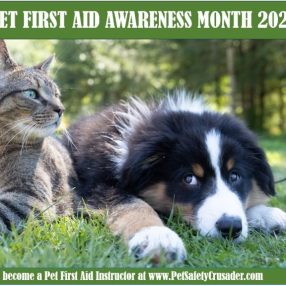 Although “I Don’t Like Spiders and Snakes” was a big hit for Jim Stafford back in 1974, many people actually do enjoy sharing their lives with crawling beings. When worlds collide and one of these beings goes rogue, biting or stinging our four-legged best friend, we must know what to do BEFORE we even get to veterinary help!
Although “I Don’t Like Spiders and Snakes” was a big hit for Jim Stafford back in 1974, many people actually do enjoy sharing their lives with crawling beings. When worlds collide and one of these beings goes rogue, biting or stinging our four-legged best friend, we must know what to do BEFORE we even get to veterinary help!
Dogs and cats are natural hunters and often go in search of smaller animals as prey, but like humans…they can experience an allergic or inflammatory reaction if not worse when bitten or stung by a venomous creature. Most injuries occur on the face or in the mouth since cats and dogs snap at or try to catch the flying and crawling critters in their mouths, but they can also sit or step on a stinging insect, arachnid or venomous reptile.
An Ounce of Prevention…
- Keep down the insect population by not leaving food outside, using pet-safe insecticides around the yard and growing plants (such as lemongrass or catnip) or lighting citronella candles (if safe around pets) that cause insects to stay away.
- Clear debris piles and leaves from locations where pets hang out.
- Prevent pets from sniffing under and around sheds, foundations, basements and damp areas, including places where hoses are stored, near water spigots and leaky plumbing — basically cool, dark, damp locations.
- Keep dogs on-leash when hiking so that you can steer them clear of dangerous critters.
- Stick to open paths as heavily travelled areas are less likely inhabited by reptiles.
- Don’t let pets sniff under rocks and logs (it’s where snakes hide out). Do your best to step ON fallen logs rather than over them to cover hiding places underneath and prevent the snake from striking as you and your dog step over.
- Eliminate garbage, wood piles and even ivy from pet play areas. These are favorite locales of mice, and where mice hang out…snakes line up for dinner!
- Look into a “positively reinforced” rattlesnake aversion class to see if it can lessen the prey drive in dogs eager to go on the chase.
When the Worst Happens
If you don’t see the incident occur, but notice some swelling to a body part of licking, you may assume your pet has been bitten and should administer first-aid. If however, you notice any of the following symptoms, which usually occur within one hour, seek veterinary assistance immediately: pain, fever or body temperature below 100°F, profuse swelling, rash, breathing difficulty, rapid or irregular pulse, vomiting, diarrhea, lethargy, muscle tremors or rigidness, paralysis (including of the lungs) or Shock.
SPIDERS
Most spider bites cause little more than painful swelling and should be treated like an insect sting since most spiders are unable to penetrate animal skin. There are a few species in the U.S. that are venomous (inject toxin through fangs) and can cause serious effects within 30 minutes to several hours of being stung. The problem is, unless we see a dead spider, we often don’t know what is causing the distress, so know if you have venomous spiders in your neighborhood and do your doggone best to keep pets away from the areas they nest.
Administer 1 mg Diphenhydramine for every pound pet weighs, and since spider toxin also contains acid, apply an alkaline baking soda or meat tenderizer (containing papain) made into a paste by mixing with small amounts of water. This may counteract the acidity if you can locate the site of the sting. Apply a cold pack to any swelling, but remove every few minutes to prevent frostbite. If you suspect the bite was caused by a venomous spider, also restrain movement (movement hastens the spread of venom) and get him quickly to veterinary care, bringing along the dead spider for identification.
 SNAKES
SNAKES
Even those without venom (toxic saliva) carry bacteria in their mouths (most don’t brush their teeth and consume rats and mice on a daily basis) which can cause infection in your pet. The physical appearance of each snake species varies, and it may be difficult to tell which species you’ve encountered unless you are familiar with herpetology (the study of amphibians and reptiles).
Venomous vs Non-Venomous Snakes
Here are general guidelines to determine if what you are seeing is venomous, but there are always exceptions to the rule. Learn to identify snakes in your regions so that you do not mistakenly kill and eco-friendly one or get bitten by a venomous snake…
- A broad, triangular head with a noticeable “neck,” but other species can flare their heads when agitated
- Vertical slits for pupils (hopefully you won’t be close enough to evaluate this!)
- “Pit vipers” have heat-sensing “pits” (thermo-receptors) on their faces between the eye
and nostril which help them locate prey, especially warm-blooded animals.
- Two fangs which leave puncture wounds
- Rattles on some species but they do not always issue a warning as the sound signals prey which could be a tasty meal. Other snakes may rustle their tails in dry debris, but it does not sound the same as a rattlesnake rattling. Watch this: https://youtu.be/qRW1-q1SU5U
 Venomous snakes can be found in rural and suburban areas. In cold climates most hibernate from November through March. In warmer climates, however they are active year-round, and after mild winters, come out of hibernation early. Learn which species are indigenous to your neighborhood.
Venomous snakes can be found in rural and suburban areas. In cold climates most hibernate from November through March. In warmer climates, however they are active year-round, and after mild winters, come out of hibernation early. Learn which species are indigenous to your neighborhood.
Most snakes can control the amount of venom they inject and may deliver a “dry” bite to a human or large animal. Baby snakes, however, are born with venom and the means to inject it but aren’t yet “fang trained,” so generally hold on longer and deliver all the venom they have at one time. Hemotoxic venom disrupts the integrity of the blood vessels causing swelling as blood seeps into the tissue and prevents clotting. It also breaks down the tissue and “pre-digests” it making it easier for the snake to consume. Neurotoxic venom results in paralysis including that of the respiratory muscles ending in suffocation. Some snakes possess both types.
The degree of severity of any venomous snake bite depends on:
- The species & size of snake
- The size of the animal bitten
- The amount of venom injected
If you are certain it was a non-venomous snake…
Wash the wound with antibacterial soap and observe. If red or warm to the touch, get to the veterinarian for antibiotics or other treatment.
If you suspect it was a venomous snake:
- Keep animal calm – the faster he moves, the faster the venom circulates.
- Keep bite wound at heart level if possible as most of us won’t be able to tell degree of damage, yet…If bite is producing localized damage, elevate to prevent or decrease swelling and additional tissue damage, BUT…if the bite is producing systemic symptoms like shock or bleeding, lower the wound.
- Get to the animal ER at once! Treatment should begin within 30 minutes of the bite, and it takes 30 minutes to mix the antidote. Some clinics are starting to carry a reconstituted version but make sure they have plenty on hand by calling ahead.
Do NOT cut over the bite and try to suck out the poison.
Do NOT manipulate the bitten area or allow the pet to move about freely.
Do NOT place an ice pack over the bite which will concentrate the toxin causing extensive, irreparable tissue damage.
Rattlesnake Vaccine is not a cure-all but can minimize the severity of the bite. Check with your veterinarian for details.
LEARN MORE IN “THE PET SAFETY BIBLE” available on Amazon!
Please catch my VLOG on this topic: https://youtu.be/8chPYAGOcSU
__________________________________________________________
For 20 years Denise Fleck’s Sunny-dog Ink motto has been “Helping people to help their pets,” and she has…teaching more than 30,000 pet lovers animal life-saving skills and millions more on “The Doctors,” CNN, “Kirstie Alley’s Big Life,” Animal Planet and other TV shows. Denise is a frequent conference speaker, developed a line of pet first aid kits and now offers classes online.
Note: The articles on this page are copyrighted. Please do not reprint or use portions for any purpose without written permission from the author. Request permission for usage by sending an email explaining how you’d like to use the materials and what parts specifically. Thank you in advance!










